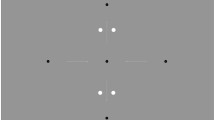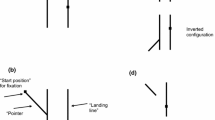Abstract
When a tracked target is occluded transiently, extraretinal signals are known to maintain smooth pursuit, albeit with a reduced gain. The extent to which extraretinal signals incorporate predictions of time-varying behavior, such as gradual changes in target direction, is not known. Three experiments were conducted to examine this question. In the experiments, subjects tracked a target that initially moved along a straight path, then (briefly) followed the arc of a circle, before it disappeared behind a visible occlusion. In the first experiment, the target did not emerge from the occlusion and subjects were asked to point to the location where they thought the target would have emerged. Gaze and pointing behaviors demonstrated that most of the subjects predicted that the target would follow a linear path through the occlusion. The direction of this extrapolated path was the same as the final visible target direction. In the second set of experiments, the target did emerge after following a curvilinear path through the occlusion, and subjects were asked to track the target with their eyes. Gaze behaviors indicated that, in this experimental condition, the subjects predicted curvilinear target motion while the target was occluded. Saccades were directed to the unseen curvilinear path and pursuit continued to follow this same path at a reduced speed in the occlusion. Importantly, the direction of smooth pursuit continued to change throughout the occlusion. Smooth pursuit angular velocity was maintained for approximately 200 ms following target disappearance. The results of the experiments indicate that extraretinal signals indeed incorporate cognitive expectations about the time-varying behavior of target motion.












Similar content being viewed by others
References
Bahill AT, McDonald JD (1983) Model emulates human smooth pursuit system producing zero-latency target tracking. Biol Cybern 48:213–222
Barnes GR (1982) A procedure for the analysis of nystagmus and other eye movements. Aviat Space Environ Med 53:676–682
Barnes GR, Barnes DM, Chakraborti SR (2000) Ocular pursuit responses to repeated, single-cycle sinusoids reveal behavior compatible with predictive pursuit. J Neurophysiol 84:2340–2355
Becker W, Fuchs AF (1985) Prediction in the oculomotor system: smooth pursuit during transient disappearance of a visual target. Exp Brain Res 57:562–575
Bennett SJ, Barnes GR (2003) Human ocular pursuit during the transient disappearance of a visual target. J Neurophysiol 90:2504–2520
Bennett SJ, Barnes GR (2004) Predictive smooth ocular pursuit during the transient disappearance of a visual target. J Neurophysiol 92:578–590
Bennett SJ, Barnes GR (2006) Combined smooth and saccadic ocular pursuit during the transient occlusion of a moving visual object. Exp Brain Res 168:313–321
van den Berg AV (1988) Human smooth pursuit during transient perturbations of predictable and unpredictable target movement. Exp Brain Res 72:95–108
Beutter BR, Stone LS (2000) Motion coherence affects human perception and pursuit similarly. Vis Neurosci 17:139–153
de Brouwer S, Missal M, Lefevre P (2001) Role of retinal slip in the prediction of target motion during smooth and saccadic pursuit. J Neurophysiol 86:550–558
de Brouwer S, Yuksel D, Blohm G, Missal M, Lefevre P (2002) What triggers catch-up saccades during visual tracking? J Neurophysiol 87:1646–1650
Churchland MM, Lisberger SG (2001) Experimental and computational analysis of monkey smooth pursuit eye movements. J Neurophysiol 86:741–759
Churchland MM, Chou IH, Lisberger SG (2003) Evidence for object permanence in the smooth-pursuit eye movements of monkeys. J Neurophysiol 90:2205–2218
Collewijn H, Tamminga EP (1984) Human smooth and saccadic eye movements during voluntary pursuit of different target motions on different backgrounds. J Physiol 351:217–250
Engel KC, Soechting JF (2003) Interactions between ocular motor and manual responses during two-dimensional tracking. Prog Brain Res 142:141–153
Engel KC, Anderson JH, Soechting JF (1999) Oculomotor tracking in two dimensions. J Neurophysiol 81:1597–1602
Flanagan JR, Wing AM (1997) The role of internal models in motion planning and control: evidence from grip force adjustments during movements of hand-held loads. J Neurosci 17:1519–1528
Kao GW, Morrow MJ (1994) The relationship of anticipatory smooth eye movement to smooth pursuit initiation. Vision Res 34:3027–3036
Kawato M (1999) Internal models for motor control and trajectory planning. Curr Opin Neurobiol 9:718–727
Kowler E (1989) Cognitive expectations, not habits, control anticipatory smooth oculomotor pursuit. Vision Res 29:1049–1057
Kowler E, Steinman RM (1979a) The effect of expectations on slow oculomotor control. I. Periodic target steps. Vision Res 19:619–632
Kowler E, Steinman RM (1979b) The effect of expectations on slow oculomotor control. II. Single target displacements. Vision Res 19:633–646
Kowler E, Steinman RM (1981) The effect of expectations on slow oculomotor control-III. Guessing unpredictable target displacements. Vision Res 21:191–203
Kowler E, Martins AJ, Pavel M (1984) The effect of expectations on slow oculomotor control–IV. Anticipatory smooth eye movements depend on prior target motions. Vision Res 24:197–210
Krauzlis RJ, Lisberger SG (1994) A model of visually-guided smooth pursuit eye movements based on behavioral observations. J Comput Neurosci 1:265–283
Lisberger SG (1998) Postsaccadic enhancement of initiation of smooth pursuit eye movements in monkeys. J Neurophysiol 79:1918–1930
Lisberger SG, Morris EJ, Tychsen L (1987) Visual motion processing and sensory-motor integration for smooth pursuit eye movements. Annual Rev Neurosci 10:97–129
Madelain L, Krauzlis RJ (2003) Effects of learning on smooth pursuit during transient disappearance of a visual target. J Neurophysiol 90:972–982
Mrotek LA, Flanders M, Soechting JF (2004) Interception of targets using brief directional cues. Exp Brain Res 156:94–103
Mrotek LA, Flanders M, Soechting JF (2006) Oculomotor responses to gradual changes in target direction. Exp Brain Res 172:175–192
Pola J, Wyatt HJ (1997) Offset dynamics of human smooth pursuit eye movements: effects of target presence and subject attention. Vision Res 37:2579–2595
Robinson DA, Gordon JL, Gordon SE (1986) A model of the smooth pursuit eye movement system. Biol Cybern 55:43–57
Soechting JF, Mrotek LA, Flanders M (2003) Time constants in the perception of a change in the direction of motion in humans. Neurosci Lett 348:56–60
Steinbach MJ (1976) Pursuing the perceptual rather than the retinal stimulus. Vision Res 16:1371–1376
Wells SG, Barnes GR (1999) Predictive smooth pursuit eye movements during identification of moving acuity targets. Vision Res 39:2767–2775
Zago M, Bosco G, Maffei V, Iosa M, Ivanenko YP, Lacquaniti F (2004) Internal models of target motion: expected dynamics overrides measured kinematics in timing manual interceptions. J Neurophysiol 91:1620–1634
Acknowledgments
This work was supported by NIH Grants EY-13704 and NS-15018. We thank Dr. Martha Flanders for helpful comments on earlier versions of this manuscript.
Author information
Authors and Affiliations
Corresponding author
Rights and permissions
About this article
Cite this article
Mrotek, L.A., Soechting, J.F. Predicting curvilinear target motion through an occlusion. Exp Brain Res 178, 99–114 (2007). https://doi.org/10.1007/s00221-006-0717-y
Received:
Accepted:
Published:
Issue Date:
DOI: https://doi.org/10.1007/s00221-006-0717-y




